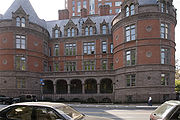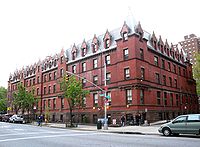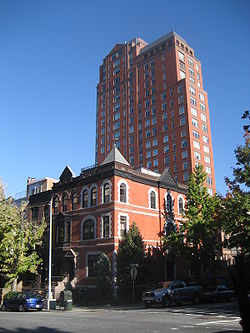
Manhattan Valley
Encyclopedia

Upper West Side
The Upper West Side is a neighborhood in the borough of Manhattan, New York City, that lies between Central Park and the Hudson River and between West 59th Street and West 125th Street...
of Manhattan
Manhattan
Manhattan is the oldest and the most densely populated of the five boroughs of New York City. Located primarily on the island of Manhattan at the mouth of the Hudson River, the boundaries of the borough are identical to those of New York County, an original county of the state of New York...
in New York City
New York City
New York is the most populous city in the United States and the center of the New York Metropolitan Area, one of the most populous metropolitan areas in the world. New York exerts a significant impact upon global commerce, finance, media, art, fashion, research, technology, education, and...
, bounded by West 110th Street
110th Street (Manhattan)
110th Street is a street in the New York City borough of Manhattan. It is commonly known as the boundary between Harlem and Central Park, along which it is known as Central Park North. In the west, it is also known as Cathedral Parkway....
to the north, Central Park West
Central Park West
Central Park West is an avenue that runs north-south in the New York City borough of Manhattan, in the United States....
to the east, West 96th Street
96th Street (Manhattan)
96th Street is a major two-way street in East Harlem and the Upper West Side, which is a part of the New York City borough of Manhattan, running from the East River at the FDR Drive to the Henry Hudson Parkway at the Hudson River...
to the south, and Broadway
Broadway (New York City)
Broadway is a prominent avenue in New York City, United States, which runs through the full length of the borough of Manhattan and continues northward through the Bronx borough before terminating in Westchester County, New York. It is the oldest north–south main thoroughfare in the city, dating to...
to the west. It was formerly known as the Bloomingdale District
Bloomingdale District
Bloomingdale is a part of Manhattan's Upper West Side between 96th and 110th Streets and bounded on the east by Amsterdam Avenue and on the west by Riverside Drive, Riverside Park and the Hudson River.-History:...
, a name still in occasional use.
Geography
Manhattan Valley occupies a natural depression running east-west across Manhattan, declining rapidly from high rocky bluffs at the western border of modern Central ParkCentral Park
Central Park is a public park in the center of Manhattan in New York City, United States. The park initially opened in 1857, on of city-owned land. In 1858, Frederick Law Olmsted and Calvert Vaux won a design competition to improve and expand the park with a plan they entitled the Greensward Plan...
, and following west the valley created by what was once a minor stream draining from roughly the area of the Harlem Meer into the Hudson River
Hudson River
The Hudson is a river that flows from north to south through eastern New York. The highest official source is at Lake Tear of the Clouds, on the slopes of Mount Marcy in the Adirondack Mountains. The river itself officially begins in Henderson Lake in Newcomb, New York...
.
Some sources consider the southern boundary of Manhattan Valley to be West 100th Street, but a more natural division preferred by community groups extends the area south to West 96th Street
96th Street (Manhattan)
96th Street is a major two-way street in East Harlem and the Upper West Side, which is a part of the New York City borough of Manhattan, running from the East River at the FDR Drive to the Henry Hudson Parkway at the Hudson River...
, a major thoroughfare which runs in its own natural valley and stretches across town through Central Park.
Broadway and Central Park West are busy north/south thoroughfares through the neighborhood. Others include, west to east, Amsterdam Avenue
Tenth Avenue (Manhattan)
Tenth Avenue, known as Amsterdam Avenue north of 59th Street, is a north-south thoroughfare on the West Side of Manhattan in New York City. It carries uptown traffic as far as West 110th Street, also known as Cathedral Parkway for the Cathedral Church of St. John the Divine...
, Columbus Avenue
Ninth Avenue (Manhattan)
Ninth Avenue / Columbus Avenue is a southbound thoroughfare on the West Side of Manhattan in New York City. Traffic runs downtown along its full length...
, and Manhattan Avenue
Manhattan Avenue
Manhattan Avenue is the name of two streets in New York City.-Brooklyn:Manhattan Avenue is a north-south thoroughfare in the Brooklyn neighborhoods of Greenpoint and Williamsburg. It is the major shopping street in Greenpoint while it is mostly residential in Williamsburg...
. The former two extend through the entirety of the Upper West Side (and beyond). The last originates at 100th Street and proceeds north into Harlem.
Several large swaths of Manhattan Valley on the west side are made up of residential developments which break the regular city street grid. The area from West 100th to 97th Street between Central Park West and Amsterdam Avenue consists of an extended Title I "towers in a park" housing development. Another superblock, occupied by the Frederick Douglass Houses
Frederick Douglass Houses
The Frederick Douglass Houses are a public housing project located in the New York City borough of Manhattan, in the Manhattan Valley neighborhood of Upper West Side, named for civil rights pioneer Frederick Douglass. The actual buildings are located between 100th Street and 104th Street, to the...
lies just to the north, bordered by Amsterdam Avenue, West 100th Street, Manhattan Avenue, and West 104th Street. Columbus Avenue also passes through both of these developments. All other streets in the neighborhood proceed in an uninterrupted grid.
History

Bloomingdale District
Bloomingdale is a part of Manhattan's Upper West Side between 96th and 110th Streets and bounded on the east by Amsterdam Avenue and on the west by Riverside Drive, Riverside Park and the Hudson River.-History:...
of Manhattan. Early development in the 1870s and 1880s focused on institutional care for the ill or aged, and included the Hebrew Home for the Aged, the Catholic Old Age Home and the Home for Respectable Aged Indigent Females, as well as the Towers Nursing Home constructed as a cancer ward by John Jacob Astor III
John Jacob Astor III
John Jacob Astor III was the elder son of William Backhouse Astor, Sr. and the wealthiest member of the Astor family in his generation...
in 1884. These, together with the Lion Brewery
Lion Brewery New York
Lion Brewing was a brewery operating in New York City from 1850 to 1944.Shortly after immigrating to the USA, Swiss-German August Schmid and Emanuel Bernheimer founded the Costanz Brewery at East 4th Street near Avenue B in 1850. The brewery produced a lagered beer, a favorite among German...
, gave the area its earliest landmarks.
The neighborhood began to fill out residentially at the end of the 19th century and beginning of the 20th, when first the IRT Ninth Avenue Line
IRT Ninth Avenue Line
The IRT Ninth Avenue Line, often called the Ninth Avenue El, was the first elevated railway in New York City. It opened in 1868 as the West Side and Yonkers Patent Railway, a cable-hauled line. It ceased operation in 1940....
in 1870 and then the IRT Broadway – Seventh Avenue Line in 1904 allowed the public ready access to uptown Manhattan. Columbia's purchase of the Bloomingdale Lunatic Asylum at around the same time as the Broadway line's arrival naturally made the neighborhood more attractive as well.
The area was populated mostly by Irish and German immigrants in the 1930s through 1950s. Young boys and girls took advantage of Central Park and Riverside Drive
Riverside Drive (Manhattan)
Riverside Drive is a scenic north-south thoroughfare in the Manhattan borough of New York City. The boulevard runs on the west side of Manhattan, generally parallel to the Hudson River from 72nd Street to near the George Washington Bridge at 181st Street...
or played stick ball and roller hockey in the streets. The 1950s saw many immigrants from Puerto Rico
Puerto Rico
Puerto Rico , officially the Commonwealth of Puerto Rico , is an unincorporated territory of the United States, located in the northeastern Caribbean, east of the Dominican Republic and west of both the United States Virgin Islands and the British Virgin Islands.Puerto Rico comprises an...
take up residence in the Upper West Side and a proposed project to eliminate the older brownstone apartments began to drive earlier residents to the suburbs.
The area went into decline in the 1950s and 1960s, mirroring a general urban deterioration in Manhattan. The acute problems in Manhattan Valley began then as well, when several city blocks were demolished under Robert Moses
Robert Moses
Robert Moses was the "master builder" of mid-20th century New York City, Long Island, Rockland County, and Westchester County, New York. As the shaper of a modern city, he is sometimes compared to Baron Haussmann of Second Empire Paris, and is one of the most polarizing figures in the history of...
's urban renewal
Urban renewal
Urban renewal is a program of land redevelopment in areas of moderate to high density urban land use. Renewal has had both successes and failures. Its modern incarnation began in the late 19th century in developed nations and experienced an intense phase in the late 1940s – under the rubric of...
programs to construct the Frederick Douglass Houses
Frederick Douglass Houses
The Frederick Douglass Houses are a public housing project located in the New York City borough of Manhattan, in the Manhattan Valley neighborhood of Upper West Side, named for civil rights pioneer Frederick Douglass. The actual buildings are located between 100th Street and 104th Street, to the...
in the superblock where they stand today. Rampant graft and corruption associated with the project, however, blighted their opening and brought ill repute on the neighborhood, and the debacle contributed strongly to Moses's fall from power and ouster. Two decades of general malaise settled over progress in the neighborhood.
With the Wall Street
Wall Street
Wall Street refers to the financial district of New York City, named after and centered on the eight-block-long street running from Broadway to South Street on the East River in Lower Manhattan. Over time, the term has become a metonym for the financial markets of the United States as a whole, or...
boom in the early 1980s, Manhattan as a whole experienced a sharp recovery. Seventy years after the Bloomingdale Asylum's closing, the provenance of the name was fading into obscurity, and residents and brokers alike began referring to the neighborhood by its present name. The new name and recovery were both much bolstered by the foundation in 1968 of the non-profit Manhattan Valley Development Corporation. It sought to differentiate itself from other community development organizations by opposing the demolition of pre-war buildings in favor of renovation, and seeking to promote small business and "prevent harassment by out-side management companies prevalent in low income 'minority' neighborhoods."
Wavering property prices in the late 1980s and early 1990s, combined with the rise of crack
Crack cocaine
Crack cocaine is the freebase form of cocaine that can be smoked. It may also be termed rock, hard, iron, cavvy, base, or just crack; it is the most addictive form of cocaine. Crack rocks offer a short but intense high to smokers...
use and dealers in the area, brought a halt to new investment, and the nightlife in the area stagnated in the face of crime; Manhattan Valley earned a reputation as one of the easiest places in the city to score a hit.
Modern developments

Harlem
Harlem is a neighborhood in the New York City borough of Manhattan, which since the 1920s has been a major African-American residential, cultural and business center. Originally a Dutch village, formally organized in 1658, it is named after the city of Haarlem in the Netherlands...
, under steady encroachment north from the "traditional" Upper West Side and south from Morningside Heights. Coinciding with this transition, the Columbus Amsterdam Business Improvement District organized in the late 1990s to develop stronger business presence along the main thoroughfares of Columbus and Amsterdam, and to provide entrepreneurial opportunities to locals.
While Broadway still provides most retail shopping opportunities, Amsterdam Avenue has emerged as a major contender in local nightlife with a glut of six bars in the two blocks from West 110th Street to 108th Street. These join the Ding-Dong Lounge on Columbus. The renaissance has much to do with increased migration of Columbia and Barnard College
Barnard College
Barnard College is a private women's liberal arts college and a member of the Seven Sisters. Founded in 1889, Barnard has been affiliated with Columbia University since 1900. The campus stretches along Broadway between 116th and 120th Streets in the Morningside Heights neighborhood in the borough...
students south as Morningside Heights venues become increasingly expensive.
Brokers report the properties in the area remain up to thirty percent less expensive than comparable Upper West Side neighborhoods. The neighborhood's proximity to the much-valued Central Park as well as to three separate subway lines make it attractive to young commuters, and as of 2006 prices were rising dramatically as New Yorkers were "tipped off" by their brokers. Many historical brownstones and townhouses were saved by the Manhattan Valley Development Corporation (MVDC) from demolition, particularly east of Columbus Avenue, where the property values are the highest. Yet the area remains heavily diverse, representing a microcosm of the larger city in terms of the different ethnicities, ages and socioeconomic groups living within the same community.
Landmarks
- Frederick Douglass CircleFrederick Douglass CircleFrederick Douglass Circle is a traffic circle located at the Northwest corner of Central Park at the foot of Frederick Douglass Boulevard and of Cathedral Parkway in the New York City borough of Manhattan...
, Central Park West and West 110th Street - Towers Condominium, "The DakotaThe DakotaThe Dakota, constructed from October 25, 1880 to October 27, 1884, is a co-op apartment building located on the northwest corner of 72nd Street and Central Park West in the Upper West Side of Manhattan in New York City...
of the North," Central Park West and West 105th Street - The former East River Savings Bank, now a pharmacy and called the "Aspirineum," Amsterdam and West 96th Street
- Church of the Ascension, West 107th Street between Broadway and Amsterdam
- Straus ParkStraus ParkStraus Park is a small landscaped park in Morningside Heights, Manhattan, at the intersection of Broadway, West End Avenue, and 106th Street....
, Broadway and West 106th Street
Demographics

External links
Sources
- Hopper Striker Mott, The New York of Yesterday: A Descriptive Narrative of Old Bloomingdale, 1908.
- Peter Salwen, Upper West Side Story 1989, ISBN 0-89659-894-2.

